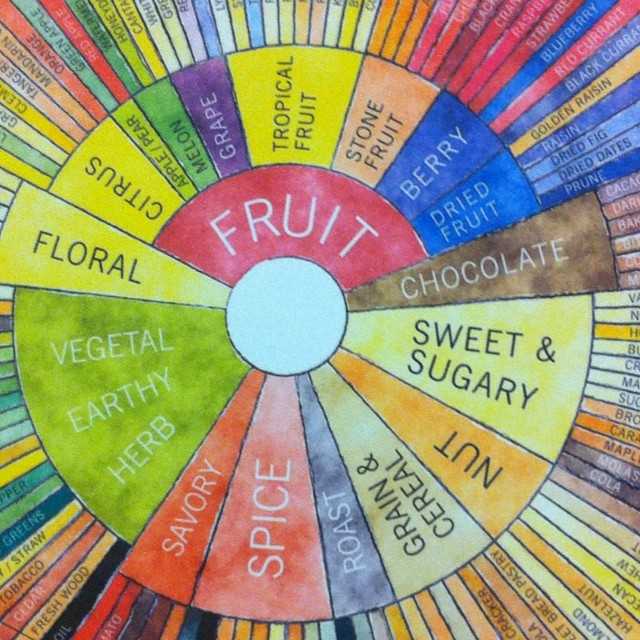Learning essentials of SCAA Coffee Flavor Wheel the origin of coffee flavor wheel
Coffee has only four kinds of water-soluble tastes: sour, sweet, bitter and salty, some sour and sweet, only volatile, which need to be identified by smell; some are non-volatile, only water-soluble, and need to be identified by taste buds; and some sweet and sour ingredients are both volatile and water-soluble, so sour and sweet often show the dual senses of smell and taste. As for bitterness and saltiness, they are not volatile and cannot be smelled with the nose, so they belong to the taste category of taste identification.
The sour, sweet, bitter and salty taste of coffee is closely related to the degree of roasting, so the "taste spectrum" is classified by shallow roasting and deep baking and re-roasting. Coincidentally, the shallow medium-baked "sour and sweet" flavor has lower molecular weight, higher polarity and high water solubility, and is often dissolved in the first half of the extraction. However, the "bitter and salty" flavor has high molecular weight, low polarity and low water solubility, so it is often dissolved in the second half of extraction.
The taste of coffee from light to medium roasting is mainly low molecular weight and medium molecular weight sour and sweet taste, but too many defective beans or improper roasting, even shallow roasting will produce a thankless bitter and salty taste. As for deep baking, it is mainly bitter and salty with high molecular weight. Unless you are familiar with the deep baking methods of traditional drum roasters, it is not easy to break the fate of deep baked beans with salty taste. But deep baking is by no means useless. The rarest deep-baked flavor spectrum is "thick but not bitter, sweet and mellow to moisten the throat". After experiments, it is not a myth. Generally speaking, 70% to 72% of roasted coffee beans are insoluble in water, and the water-soluble flavor ingredients account for only 28% to 30% of the weight of cooked beans. What are the contents of these soluble flavors? the Coffee Cup Tester Handbook, written by Ringer, a senior consultant to SCAA, contains relevant data.
The percentage indicates the weight ratio of each flavor ingredient to the soluble substance of coffee.
According to the above data, the weight proportion of sour, sweet, bitter and salty soluble flavors of coffee cooked beans is obviously the most, accounting for 39% of the soluble substances, followed by bitter substances (264%), salty taste (4%), sour taste (lowest) and not more than 54%. The total is 848%, and the rest unlisted should be flavors with less content. However, Ringer did not specify the baking degree of the sampling, so let's take the cup to measure the usual moderate baking Agtron#55, depending on the baking degree, these values will be different, but as long as the baking degree is within the palatable range, the order of the proportion of the above flavors will not change.
Please do not think that the proportion of sweetness is the highest, and coffee is supposed to be as sweet as honey. in fact, this is not the case. the bitter sour or even salty taste of black coffee can easily interfere with sweetness, which involves the complex relationship between sour, bitter, salty and sweet. Only when the cell walls of raw beans are thick, and the contents of sucrose and amino acids are higher than the average, coupled with perfect baking, sweetness can break away from the other three flavors, "encirclement and suppression", and stand out. So sweetness is the most valuable happy taste of boutique coffee. Sour, sweet, bitter and salty tastes may appear in shallow baking, but in the deep-baked world, organic acids have been completely cracked, and the taste spectrum is simplified to sweet, bitter and salty tastes with higher molecular weight. Start with the shallow baking "taste spectrum", and then re-bake the "taste spectrum".

Important Notice :
前街咖啡 FrontStreet Coffee has moved to new addredd:
FrontStreet Coffee Address: 315,Donghua East Road,GuangZhou
Tel:020 38364473
- Prev

Coffee roasting and Coffee Flavor Wheel New version of Coffee Flavor Wheel
The deep roasting of counter-cultural coffee flavor wheel highlights that light roasting of wood incense can highlight the bright smell of sour flowers, grasses and fruits, but hopeless deep roasting fans fall in love with resin components such as incense, smelling, choking aroma and alcohol odor. this is the product of Mena reaction and distillation. Resin composition: pine and cypress families of Pinaceae and Taxodiaceae, both secrete oleoresin with spicy fragrance to protect against insect pests or
- Next

Who invented coffee flavor wheel? the origin of coffee flavor wheel?
The Africans invented it! Coffee is native to Ethiopia. It was used as a beverage in North Africa and West Asia for hundreds of years before it was introduced into Europe in the 17th century. Coffee plantations have been set up in all hot and humid parts of the world, and coffee has become a popular drink. But it takes a lot of days to make a pot of delicious coffee. Coffee beans must be ground into fine powder. Preferably more.
Related
- Detailed explanation of Jadeite planting Land in Panamanian Jadeite Manor introduction to the grading system of Jadeite competitive bidding, Red bid, Green bid and Rose Summer
- Story of Coffee planting in Brenka region of Costa Rica Stonehenge Manor anaerobic heavy honey treatment of flavor mouth
- What's on the barrel of Blue Mountain Coffee beans?
- Can American coffee also pull flowers? How to use hot American style to pull out a good-looking pattern?
- Can you make a cold extract with coffee beans? What is the right proportion for cold-extracted coffee formula?
- Indonesian PWN Gold Mandrine Coffee Origin Features Flavor How to Chong? Mandolin coffee is American.
- A brief introduction to the flavor characteristics of Brazilian yellow bourbon coffee beans
- What is the effect of different water quality on the flavor of cold-extracted coffee? What kind of water is best for brewing coffee?
- Why do you think of Rose Summer whenever you mention Panamanian coffee?
- Introduction to the characteristics of authentic blue mountain coffee bean producing areas? What is the CIB Coffee Authority in Jamaica?

